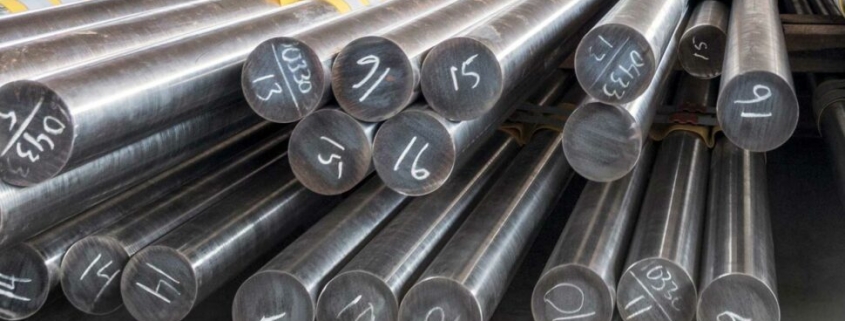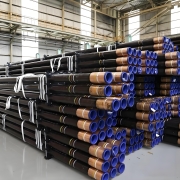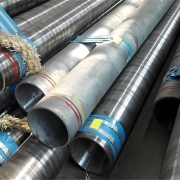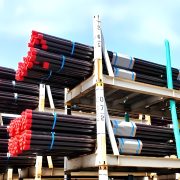Semua yang Perlu Anda Ketahui: Super 13Cr
1. Pendahuluan dan Tinjauan Umum
Super 13Cr adalah paduan baja tahan karat martensit yang dikenal karena kekuatan mekanisnya yang luar biasa dan ketahanan korosi sedang, sehingga ideal untuk lingkungan yang menuntut. Awalnya dikembangkan untuk aplikasi minyak dan gas, Super 13Cr menawarkan alternatif yang hemat biaya untuk bahan paduan yang lebih tinggi, terutama di lingkungan yang cukup korosif di mana retak korosi tegangan (SCC) yang disebabkan oleh klorida menjadi perhatian.
Karena sifat mekanisnya yang ditingkatkan dan ketahanan korosi yang lebih baik dibandingkan dengan baja tahan karat 13Cr konvensional, Super 13Cr banyak digunakan dalam industri seperti minyak dan gas, pengolahan kimia, pulp dan kertas, kelautan dan lepas pantai, pengendalian polusi udara, dan pembangkit listrik.
2. Produk dan Spesifikasi Super 13Cr yang Tersedia
Super 13Cr tersedia dalam berbagai bentuk untuk memenuhi berbagai persyaratan aplikasi:
- Nomor UNS: : S41426
- Nama Umum: Super 13Cr
- Nomor W.: 1.4009
- Standar ASTM/ASME: Bahasa Indonesia: ASTM A276, A479, A182
- Formulir Produk: Pipa, Tabung, Batang, Batang, Stok Tempa
3. Aplikasi Super 13Cr
Kombinasi kekuatan, kekerasan, dan ketahanan korosi Super 13Cr membuatnya cocok untuk berbagai aplikasi:
- Minyak dan gas: Tabung, casing, dan jaringan pipa di lingkungan yang agak korosif dengan paparan CO₂ dan H₂S terbatas.
- Pengolahan Kimia: Peralatan dan sistem perpipaan yang menangani bahan kimia yang cukup agresif.
- Pulp dan Kertas: Komponen yang terkena lingkungan pemrosesan kimia yang keras.
- Kelautan dan Lepas Pantai: Komponen dalam penanganan air laut, termasuk pompa, katup, dan struktur laut lainnya.
- Pembangkit listrik: Bilah turbin uap dan komponennya terkena suhu tinggi dan korosi.
- Pengendalian Polusi Udara: Komponen yang terkena gas buang agresif dan lingkungan asam.
- Pengolahan Makanan: Peralatan yang digunakan di lingkungan di mana kebersihan dan ketahanan terhadap korosi sangat penting.
- Tungku Rumah Tangga Efisiensi Tinggi: Penukar panas karena daya tahan material pada suhu tinggi.
4. Sifat Tahan Korosi
Super 13Cr menawarkan ketahanan korosi yang lebih baik daripada baja tahan karat 13Cr konvensional, terutama di lingkungan yang mengandung CO₂. Namun, baja ini tidak cocok untuk lingkungan dengan kandungan H₂S yang signifikan karena risiko retak tegangan sulfida. Paduan ini memberikan ketahanan korosi lubang dan celah yang baik di lingkungan yang mengandung klorida dan tahan terhadap retak korosi tegangan di bawah konsentrasi klorida sedang.
5. Sifat Fisik dan Termal
- Kepadatan: 7,7 gram/cm³
- Kisaran Peleburan: 1.400–1.450°C
- Konduktivitas Termal: 25 W/mK pada 20°C
- Panas Spesifik: 460 J/kg.K
- Koefisien Ekspansi Termal: 10,3 x 10⁻⁶/°C (20–100°C)
6. Komposisi Kimia
Komposisi kimia khas Super 13Cr meliputi:
- Kromium (Cr): 12.0–14.0%
- Nikel (Ni): 3,5–5,5%
- Molibdenum (Mo): 1,5–2,5%
- Karbon (C): ≤0,03%
- Mangan (Mn): ≤1.0%
- Silikon (Si): ≤1.0%
- Fosfor (P): ≤0,04%
- Belerang (S): ≤0,03%
- Besi (Fe): Keseimbangan
7. Sifat Mekanik
- Daya tarik: 690–930 MPa
- Kekuatan Hasil: 550–650MPa
- Pemanjangan: ≥20%
- Kekerasan: 250–320 HB
- Ketangguhan Dampak: Luar biasa, terutama setelah perlakuan panas.
8. Perlakuan Panas
Super 13Cr biasanya dikeraskan melalui perlakuan panas untuk meningkatkan sifat mekanisnya. Proses perlakuan panas melibatkan pendinginan dan tempering untuk mencapai kombinasi kekuatan dan ketangguhan yang diinginkan. Siklus perlakuan panas yang umum meliputi:
- Anil Solusi: Pemanasan hingga 950–1050°C, diikuti dengan pendinginan cepat.
- Tempering: Pemanasan ulang hingga 600–700°C untuk menyesuaikan kekerasan dan ketangguhan.
9. Membentuk
Super 13Cr dapat dibentuk secara panas atau dingin, meskipun lebih sulit dibentuk daripada jenis austenitik karena kekuatannya yang lebih tinggi dan keuletan yang lebih rendah. Pemanasan awal sebelum pembentukan dan perlakuan panas pasca-pembentukan sering kali diperlukan untuk menghindari keretakan.
10. Pengelasan
Pengelasan Super 13Cr memerlukan kontrol yang cermat untuk menghindari keretakan dan mempertahankan ketahanan terhadap korosi. Perlakuan panas pra-pemanasan dan pasca-pengelasan (PWHT) biasanya diperlukan. Bahan pengisi harus kompatibel dengan Super 13Cr untuk memastikan kualitas las. Perhatian khusus harus diberikan untuk menghindari kerapuhan hidrogen.
11. Korosi pada Las
Lasan pada Super 13Cr rentan terhadap korosi lokal, terutama di zona yang terkena panas (HAZ). Perlakuan panas pasca-las sangat penting untuk memulihkan ketahanan terhadap korosi, mengurangi tegangan sisa, dan meningkatkan ketangguhan di area yang dilas.
12. Pembersihan Kerak, Pengasinan, dan Pembersihan
Pembersihan kerak pada Super 13Cr dapat menjadi tantangan karena terbentuknya kerak oksida yang kuat selama proses pemanasan. Metode mekanis seperti peledakan atau perawatan kimia menggunakan larutan pengawet dapat digunakan untuk menghilangkan kerak. Paduan logam ini memerlukan pembersihan menyeluruh setelah pengawetan untuk menghindari kontaminasi dan memastikan ketahanan korosi yang optimal.
13. Pengerasan Permukaan
Super 13Cr dapat mengalami perlakuan pengerasan permukaan seperti nitriding untuk meningkatkan ketahanan ausnya tanpa mengurangi ketahanan terhadap korosi. Nitriding membantu meningkatkan ketahanan logam paduan dalam lingkungan yang abrasif dan dengan gesekan tinggi.
Kesimpulan
Super 13Cr menawarkan solusi serbaguna untuk industri yang membutuhkan ketahanan korosi sedang dan kekuatan mekanis tinggi. Properti seimbangnya menjadikannya pilihan populer dalam minyak dan gas, pemrosesan kimia, dan aplikasi kelautan, antara lain. Dengan memahami karakteristik uniknya—mulai dari ketahanan korosi hingga kemampuan las—insinyur dan spesialis material dapat membuat keputusan yang tepat untuk mengoptimalkan kinerja dan keawetan di lingkungan spesifik mereka.
Tulisan blog ini memberikan gambaran menyeluruh tentang spesifikasi dan sifat Super 13Cr, membekali industri dengan pengetahuan untuk memanfaatkan material canggih ini sebaik-baiknya.







